Livelihood Vulnerability of Marine Fishermen to Multi-Stresses under the Vessel Buyback and Fishermen Transfer Programs in China: The Case of Zhoushan City, Zhejiang Province
Abstract
1. Introduction
2. Theoretical Framework
2.1. The Modified Livelihood Vulnerability Framework
2.2. Indicators of Livelihood Vulnerability
3. Materials and Methods
3.1. Study Area
3.2. Index Formation and Determinants Analysis
3.3. Data Collection
3.4. Characteristics of Samples
4. Results
4.1. General Analysis of Fishermen’s Livelihood Vulnerability
4.2. Comparison of Livelihood Vulnerability for Different Types of Fishermen
4.2.1. The LVI for Non-Converted and Converted Fishermen
4.2.2. The LVI for Different Types of Converted Fishermen
4.3. The Determinants of Fishermen’s Livelihood Vulnerability
5. Discussion
5.1. Livelihoods Transformation and Livelihood Vulnerability
5.2. Implications for Improving Fishermen’s Livelihood
5.3. Comparisons with Other Studies
5.4. Prospects for Research
6. Conclusions
Supplementary Materials
Author Contributions
Funding
Acknowledgments
Conflicts of Interest
References
- Pauly, D. Small-Scale Fisheries in the Tropics: Marginality, Marginalisation, and Some Implications for Fisheries Management. In Global Trends: Fisheries Management; Pikitch, E.K., Huppert, D.D., Sissenwine, M.P., Eds.; American Fisheries Society: Bethesda, MD, USA, 1997; pp. 40–49. [Google Scholar]
- Han, L.M. Research on the “Blue Granary” Strategy in the Development of China’s Marine Industry; Economic Science Press: Beijing, China, 2018. (In Chinese) [Google Scholar]
- Food and Agriculture Organization of the United Nations. Review of the State of World Marine Fishery Resources; FAO Fisheries and Aquaculture Technical Paper No. 569; FAO: Rome, Italy, 2011. [Google Scholar]
- Cinner, J.; Daw, T.M.; McClanahan, T.R. Socioeconomic factors that affect artisanal fishers’ readiness to exit a declining fishery. Conserv. Biol. 2009, 23, 124–130. [Google Scholar] [CrossRef] [PubMed]
- Nayak, P.K. Fisher communities in transition: Understanding change from a livelihood perspective in Chilika Lagoon, India. Marit. Stud. 2017, 16, 13. [Google Scholar] [CrossRef]
- Shen, G.; Heino, M. An overview of marine fisheries management in China. Mar. Pol. 2014, 44, 265–272. [Google Scholar] [CrossRef]
- Ministry of Agriculture Bureau of Fisheries. China Fisheries Yearbook; China Agriculture Publishing Company: Beijing, China, 2000–2018. (In Chinese)
- Wang, J.Y. Analysis on the Connotation of “Transforming Fishermen into Urban Citizens” and “Fishing Industry, Fishing Village and Fishermen”. Issues Agric. Econ. 2011, 3, 72–75. (In Chinese) [Google Scholar]
- Wang, Y.L.; Wang, S.S.; Guo, D.H. Mechanism of marine fisherman social security in China based on their risk-burden situations. J. Dalian Marit. Univ. 2009, 8, 1–5. (In Chinese) [Google Scholar]
- Chen, H.M. Fisheries Resources Management Research Based on Sustainable Development; South China University of Technology: Guangzhou, China, 2009. (In Chinese) [Google Scholar]
- Sumaila, U.R.; Teh, L.; Watson, R.; Tyedmers, P.; Pauly, D. Fuel price increase, subsidies, overcapacity, and resource sustainability. ICES J. Mar. Sci. 2008, 65, 832–840. [Google Scholar] [CrossRef]
- Bunce, M.; Rosendo, S.; Brown, K. Perceptions of climate change, multiple stressors and livelihoods on marginal African coasts. Environ. Dev. Sustain. 2010, 12, 407–440. [Google Scholar] [CrossRef]
- Bennett, N.J.; Dearden, P.; Peredo, A.M. Vulnerability to multiple stressors in coastal communities: A study of the Andaman coast of Thailand. Clim. Dev. 2015, 7, 124–141. [Google Scholar] [CrossRef]
- Wu, X.Y.; Liu, G.Q.; Qi, X.; Pan, D.L.; Qi, X.H. Ecological effects of climate change and livelihood adaptations in typical fishing areas: Perceptions of fishermen’s households. Acta Ecol. Sin. 2017, 37, 313–320. (In Chinese) [Google Scholar]
- Ankrah, J. Climate change impacts and coastal livelihoods; an analysis of fishers of coastal Winneba, Ghana. Ocean Coast. Manag. 2018, 161, 141–146. [Google Scholar] [CrossRef]
- Freduah, G.; Fidelman, P.; Smith, T.F. The impacts of environmental and socio-economic stressors on small scale fisheries and livelihoods of fishers in Ghana. Appl. Geogr. 2017, 89, 1–11. [Google Scholar] [CrossRef]
- Jacinto, M.R.; Songcuan, A.J.G.; Yip, G.V.; Santos, M.D. Development and application of the fisheries vulnerability assessment tool (Fish Vool) to tuna and sardine sectors in the Philippines. Fish Res. 2015, 161, 174–181. [Google Scholar] [CrossRef]
- Baptiste, A.K.; Kinlocke, R. We are not all the same!: Comparative climate change vulnerabilities among fishers in Old Harbour Bay, Jamaica. Geoforum 2016, 73, 47–59. [Google Scholar] [CrossRef]
- Hahn, M.B.; Riederer, A.M.; Foster, S.O. The Livelihood Vulnerability Index: A pragmatic approach to assessing risks from climate variability and change—A case study in Mozambique. Glob. Environ. Chang. 2009, 19, 74–88. [Google Scholar] [CrossRef]
- Satoshi, Y.; Resosudarmo, B.P.; Wardis, G.; Hoshino, E. Productivity, Social Capital and Perceived Environmental Threats in Small-Island Fisheries: Insights from Indonesia. Ecol. Econ. 2018, 152, 62–75. [Google Scholar] [CrossRef]
- Apine, E.; Turner, L.M.; Rodwell, L.D.; Bhatta, R. The application of the sustainable livelihood approach to small scale-fisheries: The case of mud crab Scylla serrata in South west India. Ocean Coast. Manag. 2019, 170, 17–28. [Google Scholar] [CrossRef]
- Dong, X.Q. Predicament and Constructing path of Sustainability Livelihood of Sea-losing Fishermen under Background of Coastal Development: Taking Jiangsu Provincial Coastal Development as An Example. Acta Agric. Jiangxi 2013, 25, 127–130. (In Chinese) [Google Scholar]
- Chen, F.B.; Wang, C.; Samantha, P. Impact of Resettlement on livelihood of fishermen. J. Huazhong Agric. Univ. 2015, 119, 17–24. (In Chinese) [Google Scholar]
- Füssel, H.M.; Klein, R.J. Climate change vulnerability assessments: An evolution of conceptual thinking. Clim. Chang. 2006, 75, 301–329. [Google Scholar] [CrossRef]
- Nagy, G.; Azeiteiro, U.; Heimfarth, J.; Verocai, J.; Li, C. An assessment of the relationships between extreme weather events, vulnerability, and the impacts on human wellbeing in Latin America. Int. J. Environ. Res. Public Health 2018, 15, 1802. [Google Scholar] [CrossRef]
- Zhang, Y.; Shen, J.; Li, Y. Atmospheric environment vulnerability cause analysis for the Beijing-Tianjin-Hebei metropolitan region. Int. J. Environ. Res. Public Health 2018, 15, 128. [Google Scholar] [CrossRef] [PubMed]
- Farrington, J. Sustainable Livelihoods, Rights and the New Architecture of Aid; Overseas Development Institute: London, UK, 2001. [Google Scholar]
- Department for International Development. Sustainable Livelihoods Guidance Sheets; DFID: London, UK, 1999; p. 445. [Google Scholar]
- Ellis, F. Rural Livelihoods and Diversity in Developing Countries; Oxford University Press: Oxford, UK, 2000. [Google Scholar]
- Chambers, R.; Conway, G. Sustainable Rural Livelihoods: Practical Concepts for the 21st Century; IDS Discussion Paper. No. 296; Institute of Development Studies: Brighton, UK, 1992; p. 296. [Google Scholar]
- Scoones, I. Sustainable Rural Livelihoods: A Framework for Analysis; IDS Working Paper. No. 72; Institute of Development Studies: Brighton, UK, 1998; p. 72. [Google Scholar]
- Linnekamp, F.; Koedam, A.; Baud, I.S.A. Household vulnerability to climate change: Examining perceptions of households of flood risks in Georgetown and Paramaribo. Habitat Int. 2011, 35, 447–456. [Google Scholar] [CrossRef]
- Tan, S.H.; Tan, W.L.J.; Li, T.Y.; Zhu, Y.; Zhang, Q.Y.; Liu, B. Herders’ social vulnerability to climate change: Based on the investigation of four livestock husbandry banner in Xilinguole League, Inner Mongolia. Chin. Rural Econ. 2016, 7, 67–80. (In Chinese) [Google Scholar]
- Hoque, M.Z.; Cui, S.; Xu, L.; Islam, I.; Tang, J.; Ding, S. Assessing agricultural livelihood vulnerability to climate change in coastal Bangladesh. Int. J. Environ. Res. Public Health 2019, 16, 4552. [Google Scholar] [CrossRef] [PubMed]
- Can, N.D.; Tu, V.H.; Hoanh, C.T. Application of livelihood vulnerability index to assess risks from flood vulnerability and climate variability: A case study in the Mekong Delta of Vietnam. J. Environ. Sci. Eng. 2013, 2, 476–486. [Google Scholar]
- Etwire, P.M.; Al-Hassan, R.M.; Kuwornu, J.K.M. Application of livelihood vulnerability index in assessing vulnerability to climate change and variability in Northern Ghana. J. Environ. Earth Sci. 2013, 12, 157–170. [Google Scholar]
- Lee, Y.J. Social vulnerability indicators as a sustainable planning tool. Environ. Impact Assess. Rev. 2014, 44, 31–42. [Google Scholar] [CrossRef]
- Ahsan, M.N.; Warner, J. The socioeconomic vulnerability index: A pragmatic approach for assessing climate change led risks—A case study in the south-western coastal Bangladesh. Int. J. Disaster Risk Reduct. 2014, 8, 32–49. [Google Scholar] [CrossRef]
- Halpern, B.S.; Longo, C.; Hardy, D.; McLeod, K.L.; Samhouri, J.F.; Katona, S.K.; Kleisner, K.; Lester, S.E.; Leary, J.O.; Ranelletti, M.; et al. An index to assess the health and benefits of the global ocean. Nature 2012, 488, 615–620. [Google Scholar] [CrossRef]
- Thiault, L.; Marshall, P.; Gelcich, S.; Collin, A.; Chlous, F.; Claudet, J. Space and time matter in social-ecological vulnerability assessments. Mar. Policy 2018, 88, 213–221. [Google Scholar] [CrossRef]
- Yan, J.Z.; Yu, O.; Wu, Y.Y.; Zhang, Y.L. Livelihood vulnerability assessment of farmers and nomads in eastern Ecotone of Tibetan Plateau, China. Sci. Geogr. Sin. 2011, 31, 858–867. (In Chinese) [Google Scholar]
- Xu, J.; Li, S.Z.; Wu, Z.; Liu, W. The vulnerability assessment of family support for the elderly in rural China: An empirical study based on data from Anhui. Popul. Res. 2019, 43, 91–101. (In Chinese) [Google Scholar]
- Marshall, N.A.; Stokes, C.J.; Webb, N.P.; Marshall, P.A.; Lankester, A.J. Social vulnerability to climate change in primary producers: A typology approach. Agric. Ecosyst. Environ. 2014, 186, 86–93. [Google Scholar] [CrossRef]
- Bousquet, F.; Anderies, M.; Antona, M.; Bassett, T.; Benjaminsen, T.; Bonato, O.; Castro, M.; Gautier, D.; Gunderson, L.; Janssen, M.; et al. Socio-Ecological Theories and Empirical Research. Comparing Social-Ecological Schools of Thoughts in Action, 2015. Available online: https://www.researchgate.net/publication/283547500_SocioEcologicalTheoriesAndEmpiricalResearchScientificReport (accessed on 5 November 2019).
- Chen, C.; Lopez-Carr, D. The importance of place: Unraveling the vulnerability of fisherman livelihoods to the impact of marine protected areas. Appl. Geogr. 2015, 59, 88–97. [Google Scholar] [CrossRef]
- Ding, S.J.; Zhang, Y.Y.; Ma, Z.X. Research on changes of livelihood capabilities of rural households encountered by land acquisition: Based on improvement of sustainable livelihood approach. Issues Agric. Econ. 2016, 6, 25–34. (In Chinese) [Google Scholar]
- Ministry of Agriculture and Rural Affairs of China. China Fishery Statistical Yearbook (2009–2018); China Agriculture Press: Beijing, China, 2018.
- Zhoushan Statistical Bureau. Zhoushan Statistical Yearbook (2002–2018); China Statistics Press: Beijing, China, 2018. (In Chinese) [Google Scholar]
- Chen, J.N.; Yu, C.G. Marine Fishermen’s Re-employment Dilemma and Solutions: A Case Study of Zhoushan. Rural Econ. Sci. Technol. 2015, 26, 146–149. (In Chinese) [Google Scholar]
- Research Group of Zhoushan Investigation Team of National Statistical Bureau. Employment of Fishery Labor Force and Sustainable Development of Fishery under the Background of vessel buyback and fishermen transfer programs: A Case Study of Zhoushan. Stat. Theory Pract. 2018, 1, 43–46. (In Chinese) [Google Scholar]
- Keshavarz, M.; Maleksaeidi, H.; Karami, E. Livelihood vulnerability to drought: A case of rural Iran. Int. J. Disaster Risk Reduct. 2017, 21, 223–230. [Google Scholar] [CrossRef]
- Geng, A.S.; Tong, C.F. Research on Fishermen Transition under the Framework of Marine Fishery Transition. J. Anhui Agric. Sci. 2012, 40, 6199–6201, 6203. (In Chinese) [Google Scholar]
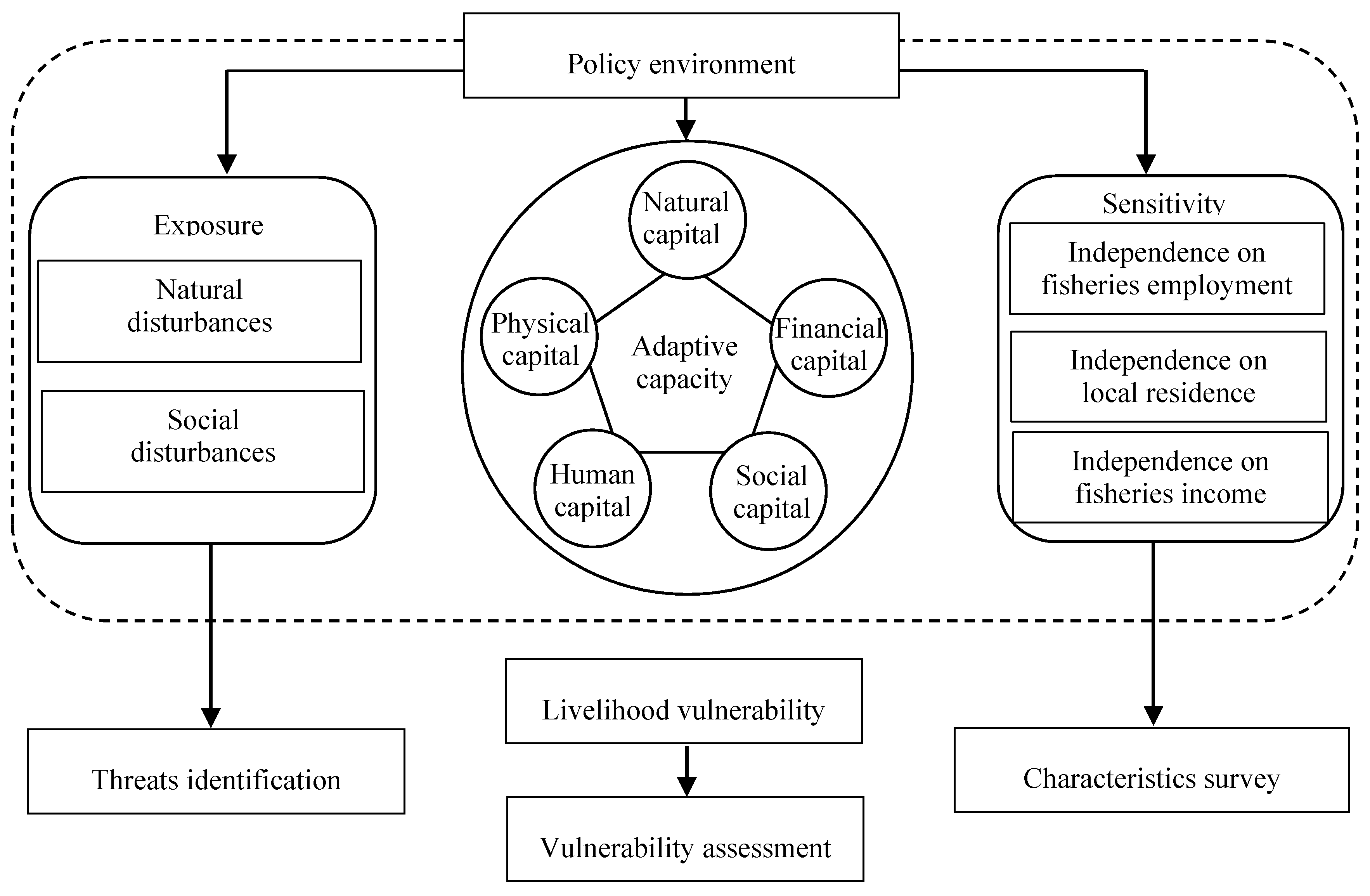
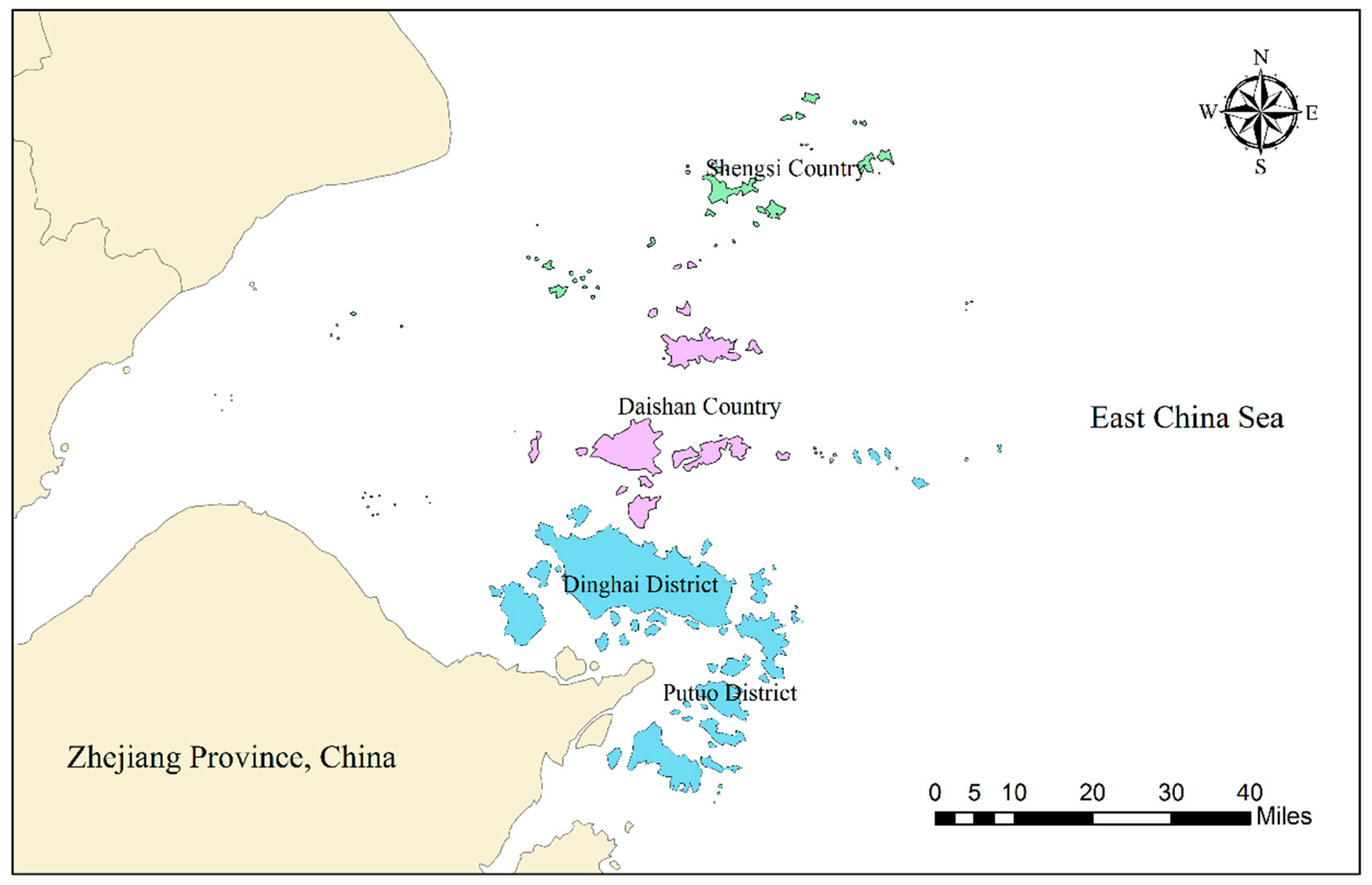
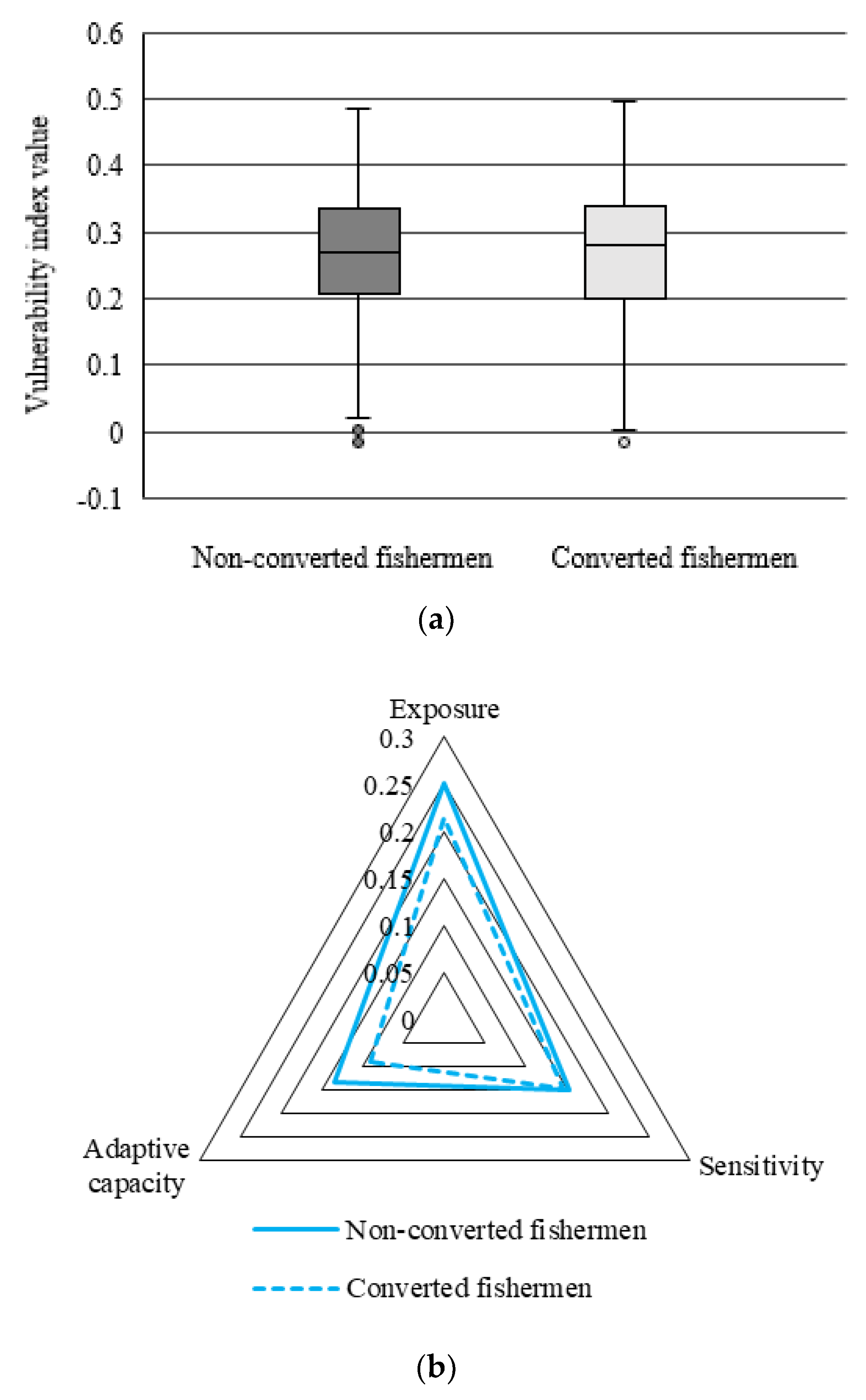
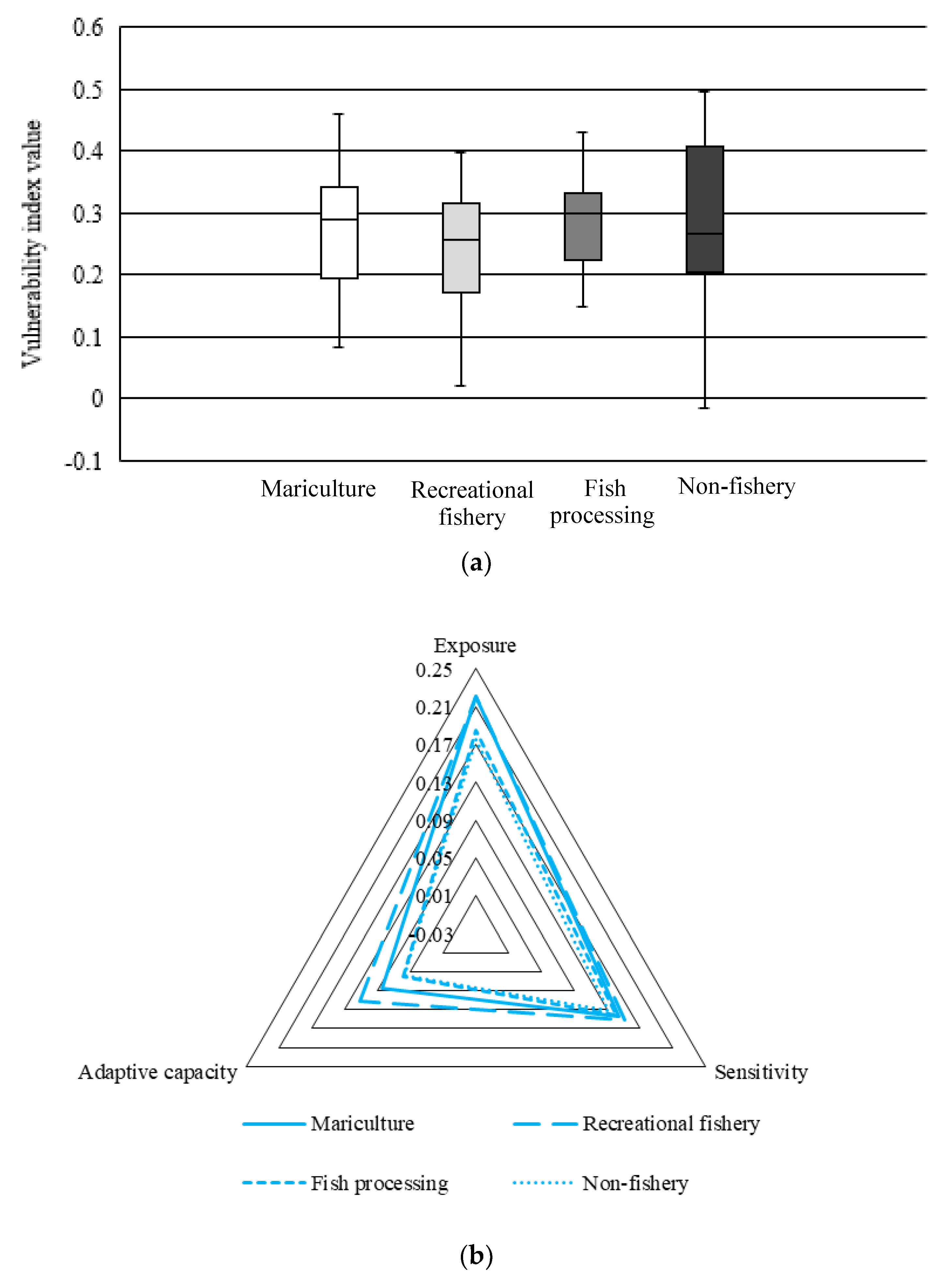
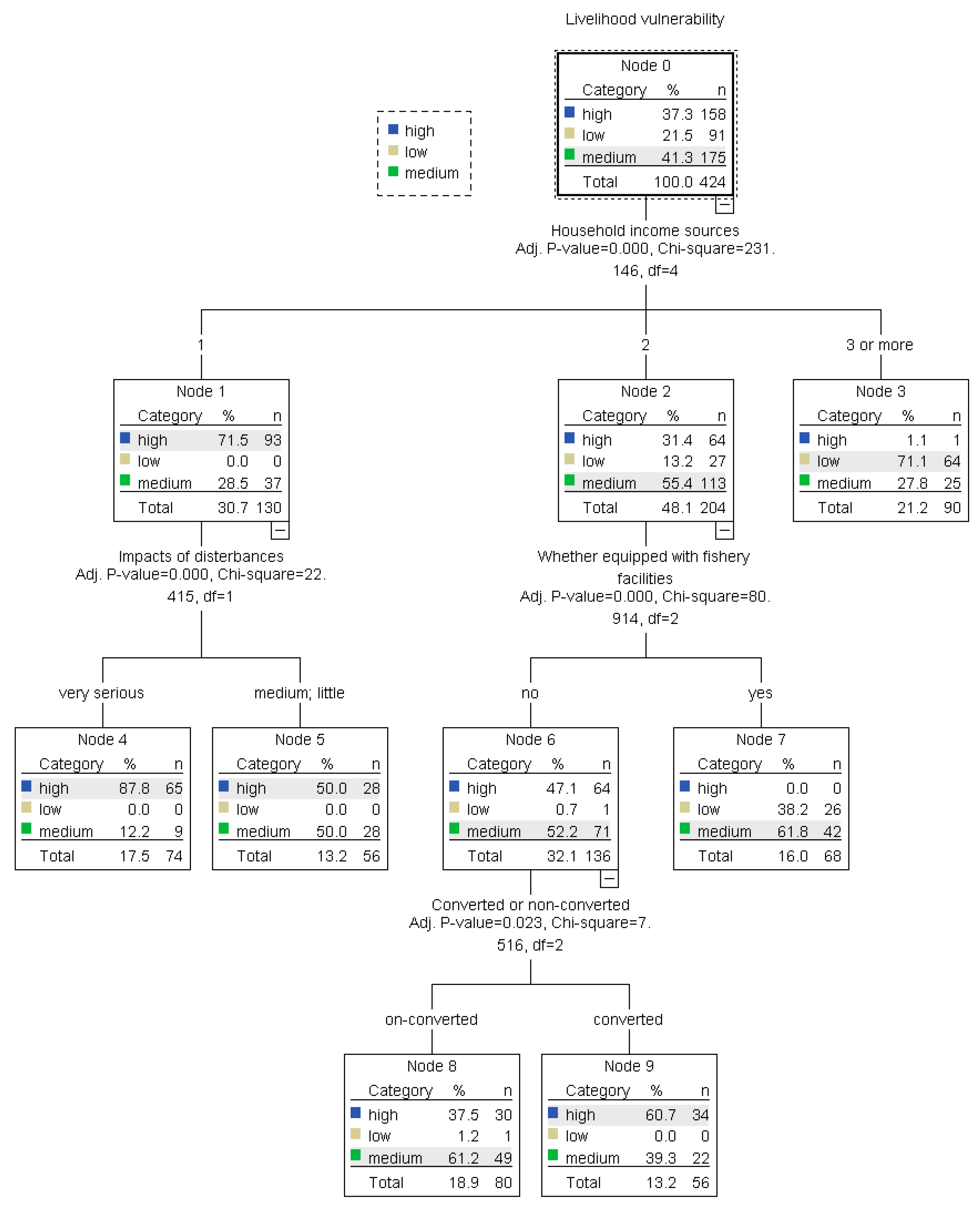
| Dimension | Component | Index Measure | Weights | Code | Mean | Standard Deviation |
|---|---|---|---|---|---|---|
| Exposure | Natural disturbances | Impacts from fishery resources recession | 0.064 | Very serious = 5, serious = 4, modest = 3, little = 2, no impacts = 1 | 3.897 | 1.331 |
| Impacts from marine environment pollution | 0.060 | Very serious = 5, serious = 4, modest = 3, little = 2, no impacts = 1 | 3.422 | 1.180 | ||
| Impacts from marine natural disasters | 0.058 | Very serious = 5, serious = 4, modest = 3, little = 2, no impacts = 1 | 3.572 | 1.101 | ||
| Social disturbances | Loss of property | 0.054 | Yes = 1, No = 0 | 0.348 | 0.467 | |
| Suffer from a major illness | 0.052 | Yes = 1, No = 0 | 0.125 | 0.304 | ||
| Lost jobs | 0.050 | Yes = 1, No = 0 | 0.189 | 0.312 | ||
| Sensitivity | Dependence on fisheries employment | Proportion of family labors who are engaged in fishery industries | 0.060 | Number of family labors who are engaged in fishery industries/Total family labors | 0.692 | 0.764 |
| Dependence on local residence | Whether want to leave hometown if you have the chance | 0.059 | Yes = 0, No = 1 | 0.263 | 0.342 | |
| Dependence on fisheries income | Proportion of fishery income to total family income | 0.058 | Very high = 4, high = 3, small = 2, very small = 1 | 3.303 | 0.799 | |
| Adaptive Capacity | Natural capital | Marine space size for fishery production | 0.048 | Very large = 5, large = 4, modest = 3, small = 2, very small = 1 | 3.353 | 2.243 |
| Physical capital | The number of housing rooms | 0.059 | One room = 1, two rooms = 2, three rooms = 3, four or more rooms = 4 | 2.994 | 1.269 | |
| Whether there are fishing vessels | 0.043 | Yes = 1, No = 0 | 1.434 | 0.845 | ||
| Whether there are mariculture or fish processing equipment | 0.042 | Yes = 1, No = 0 | 1.994 | 1.464 | ||
| Financial capital | The opportunities of getting fishery subsidies from government | 0.040 | A great many = 4, many = 3, few = 2, very few = 1 | 2.450 | 0.965 | |
| The degree of difficulties of getting loans from markets | 0.039 | Very easy = 4, easy = 3, difficult = 2, very difficult = 1 | 2.109 | 1.285 | ||
| The degree of difficulties of getting financial support from relatives and friends | 0.033 | Very easy = 4, easy = 3, difficult = 2, very difficult = 1 | 2.983 | 1.904 | ||
| Human capital | The number of youth labor force (age between 20–59) in family | 0.043 | Natural number | 1.456 | 0.707 | |
| Whether have obtained some vocational and technical training | 0.039 | Yes = 1, No = 0 | 0.306 | 0.501 | ||
| Social capital | Whether there are family members serving as village cadre | 0.037 | Yes = 1, No = 0 | 0.117 | 0.355 | |
| Whether is member of fishery co-operative or other fishery associations | 0.033 | Yes = 1, No = 0 | 0.225 | 0.418 | ||
| Number of relatives or friends who can help you in daily life | 0.029 | Natural number | 2.358 | 1.893 |
| Characteristics | Non-Converted | Converted | |||
|---|---|---|---|---|---|
| Marine Fishing | Mariculture | Recreational Fishery | Fish Processing | Non-Fishery | |
| Family size (person) | 4.05 | 4.22 | 4.17 | 3.65 | 4.78 |
| Age (year) | 55.99 | 53.29 | 52.45 | 54.5 | 52.87 |
| Household income (10,000 RMB) | 8.56 | 7.75 | 9.97 | 7.25 | 6.8 |
| Level of education (%) | |||||
| Illiterate | 8.8 | 7.69 | 5.26 | 6.67 | 13.95 |
| Primary school | 47.54 | 38.46 | 38.6 | 63.33 | 44.19 |
| Junior middle school | 34.15 | 43.59 | 49.12 | 23.33 | 30.23 |
| Senior middle school or above | 9.51 | 10.26 | 7.02 | 6.67 | 11.63 |
| Work experiences in present industry (%) | |||||
| Less than one year | 0 | 10.25 | 15.79 | 20 | 37.21 |
| One to three years | 5.89 | 38.46 | 38.6 | 46.67 | 39.53 |
| More than three years | 94.11 | 51.29 | 45.61 | 33.33 | 23.26 |
| Characteristics | Description | Total Sample | High Level | Medium Level | Low Level |
|---|---|---|---|---|---|
| Age | Year | 55.05 | 55.81 | 55.03 | 53.73 |
| Family size | Number of family members | 4.14 | 4.01 | 4.19 | 4.27 |
| Education level | Illiterate = 0, Primary school = 1, Junior middle school = 2, Senior middle school or above = 3 | 1.45 | 1.26 | 1.54 | 1.61 |
| Work experiences in present industry | Less than one year = 0, One to three years = 1, More than three years = 2 | 1.62 | 1.49 | 1.65 | 1.77 |
| Household income | Ten thousand Yuan per year | 8.33 | 7.81 | 8.48 | 8.96 |
| Number of household income sources | Natural number | 2.01 | 1.38 | 2.28 | 2.54 |
| Converted or not | Non-converted = 1, converted = 0 | 0.67 | 0.59 | 0.68 | 0.79 |
© 2020 by the authors. Licensee MDPI, Basel, Switzerland. This article is an open access article distributed under the terms and conditions of the Creative Commons Attribution (CC BY) license (http://creativecommons.org/licenses/by/4.0/).
Share and Cite
Chen, Q.; Su, H.; Yu, X.; Hu, Q. Livelihood Vulnerability of Marine Fishermen to Multi-Stresses under the Vessel Buyback and Fishermen Transfer Programs in China: The Case of Zhoushan City, Zhejiang Province. Int. J. Environ. Res. Public Health 2020, 17, 765. https://doi.org/10.3390/ijerph17030765
Chen Q, Su H, Yu X, Hu Q. Livelihood Vulnerability of Marine Fishermen to Multi-Stresses under the Vessel Buyback and Fishermen Transfer Programs in China: The Case of Zhoushan City, Zhejiang Province. International Journal of Environmental Research and Public Health. 2020; 17(3):765. https://doi.org/10.3390/ijerph17030765
Chicago/Turabian StyleChen, Qi, Hongyan Su, Xuan Yu, and Qiuguang Hu. 2020. "Livelihood Vulnerability of Marine Fishermen to Multi-Stresses under the Vessel Buyback and Fishermen Transfer Programs in China: The Case of Zhoushan City, Zhejiang Province" International Journal of Environmental Research and Public Health 17, no. 3: 765. https://doi.org/10.3390/ijerph17030765
APA StyleChen, Q., Su, H., Yu, X., & Hu, Q. (2020). Livelihood Vulnerability of Marine Fishermen to Multi-Stresses under the Vessel Buyback and Fishermen Transfer Programs in China: The Case of Zhoushan City, Zhejiang Province. International Journal of Environmental Research and Public Health, 17(3), 765. https://doi.org/10.3390/ijerph17030765





